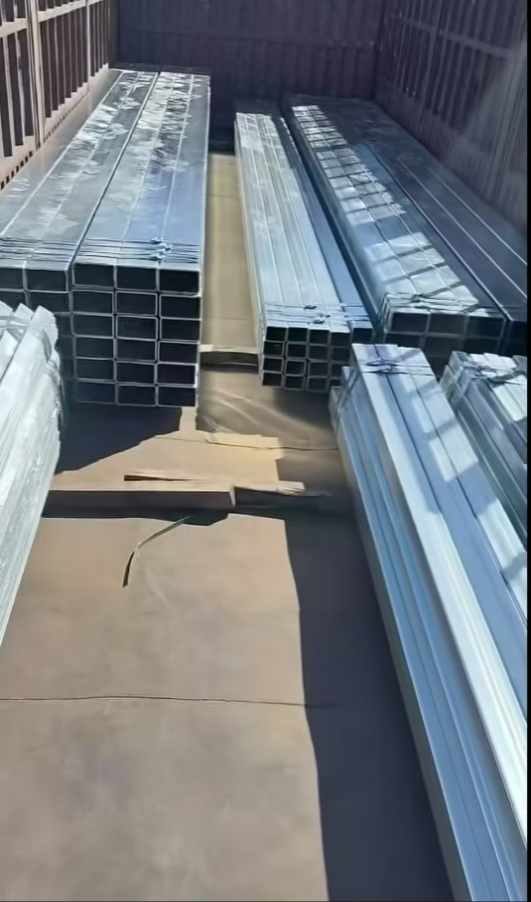Mechanical Properties Analysis Of Galvanized Steel Pipes
The mechanical properties analysis of galvanized pipes requires a comprehensive evaluation based on material properties, galvanizing process and application scenarios. The following is a detailed analysis based on the latest industry standards and research data:
I. Basic materials of galvanized pipes
1. Substrate type
1. Carbon steel: commonly used Q195, Q215, Q235 (corresponding to American standard ASTM A53 Grade B), yield strength 195-235MPa, tensile strength 315-430MPa.
2. Low alloy steel: such as Q345 (corresponding to ASTM A106 Grade B), yield strength ≥345MPa, tensile strength 470-630MPa.
3. Stainless steel: 304/316 stainless steel galvanized pipe, yield strength ≥205MPa, tensile strength ≥515MPa, corrosion resistance significantly improved.
2. Galvanizing layer parameters
1. Hot-dip galvanizing: zinc layer thickness 85-150μm (GB/T 3091-2015), zinc layer weight ≥500g/m² (ASTM A53/A53M-21).
2. Electrogalvanizing: zinc layer thickness 8-15μm, suitable for thin coating demand scenarios.
2. Core indicators of mechanical properties
1. Strength and plasticity
| Indices | Test standards | Typical value range | Influence mechanism of galvanizing |
| Streckgrenze | GB/T 228.1 | Q235: 235-265MPa | May lift 5-10% after galvanizing(work hardening) |
| Tensile strength | GB/T 228.1 | Q235: 375-500MPa | No significant change |
| Elongation after fracture | GB/T 228.1 | Q235: ≥26% | 2-5% reduction (zinc layer brittleness effect) |
| Reduction of area | GB/T 228.1 | Q235: ≥50% | Down about 10% |
2. Hardness and toughness
Surface hardness: zinc coating HV (Vickers hardness) is about 50-70, significantly lower than the steel itself (Q235 HBW≈120).
Impact toughness: -20℃ Charpy V-notch impact energy ≥27J (GB/T 18984-2016), low-temperature toughness may decrease by 10-15% after galvanizing.
3. Fatigue performance
Fatigue limit: The fatigue limit of smooth specimens is about 35-45% of the tensile strength. Defects in the galvanized layer (such as microcracks) may reduce the fatigue life by 15-20%.
III. Effect of process on performance
1. Hot-dip galvanizing
Advantages: The zinc layer and the substrate form a Fe-Zn alloy layer (thickness 5-15μm), and the bonding force is ≥35N/cm (GB/T 2694-2018).
Disadvantages: High temperature (450℃) treatment may cause grain coarsening and a decrease in elongation of 5-8%.
2. Electrogalvanizing
Advantages: No high temperature effect, maintaining the original mechanical properties of the substrate.
Disadvantages: The zinc layer has weak adhesion (cross-cut test ≥4B level), and the corrosion resistance is only 1/3-1/2 of hot-dip galvanizing.
4. Performance requirements for typical application scenarios
| Application fields | Key indicators | Recommended Materials | Performance requirements |
| Construction scaffolding | Yield strength, Welding performance | Q235 hot dip galvanized pipe | Yield strength ≥ 235 MPa, weld tensile strength ≥ 375 MPa |
| High-pressure water transmission pipe | Corrosion resistance, internal pressure resistance | Q345B Hot-dip Galvanized Pipe | Burst pressure ≥ 5 times the working pressure |
| Electric power threading pipe | Hardness, Impact resistance | 20# steel electric galvanized pipe | Rockwell hardness HRB ≥ 70 |
| Automotive drive shaft | Fatigue strength, surface wear resistance | 40Cr Galvanized Seamless Steel Pipe | Fatigue life ≥ 10⁶ cycles |
5. Standards and test methods
1. International standards
ASTM A53: The yield strength of galvanized steel pipes is ≥250MPa (Grade B) and the minimum elongation is 18%.
EN 10217-1: The thickness of the hot-dip galvanized layer is required to be ≥85μm, and the impact test temperature is -20℃.
2. Chinese standards
GB/T 3091-2015: The uniformity test of the galvanized layer is ≥5 times of copper sulfate immersion without red rust.
GB/T 13793-2016: The flattening test of the straight seam electric welded steel pipe is pressed to 1/3 of the outer diameter without cracks.
6. Performance optimization direction
1. Alloying treatment
Adding 0.1-0.3% Al can refine the grains of the galvanized layer and improve the toughness by 10-15%.
The use of Zn-Al-Mg coating (such as Zn-55% Al-1.6% Si) can improve corrosion resistance by 3-5 times without reducing mechanical properties.
2. Surface treatment
Phosphating pretreatment can enhance the adhesion of the zinc layer, and the cross-cut test can reach 5B level.
Coating epoxy resin (300-500μm) can simultaneously improve corrosion resistance and wear resistance.
VII. Summary and suggestions
1. Performance characteristics
The comprehensive mechanical properties of hot-dip galvanized pipes are slightly lower than those of the substrate, but the corrosion resistance is improved by 5-10 years.
Electro-galvanized pipes maintain the performance of the substrate, but require regular maintenance.
2. Selection suggestions
Select hot-dip galvanized Q345B for high corrosion environments, and select calm steel (such as Q235D) for low-temperature toughness requirements.
Precision mechanical parts should preferably select electro-galvanized seamless steel pipes.
3. Data limitations
The softening of the weld heat affected zone (HAZ) needs to be considered in actual engineering (hardness decreases by 15-20%).
The mechanical properties of girth welds of large diameter steel pipes (DN ≥ 300) need to be verified.


Hinterlasse einen Kommentar
An der Diskussion beteiligen?Hinterlasse uns deinen Kommentar!